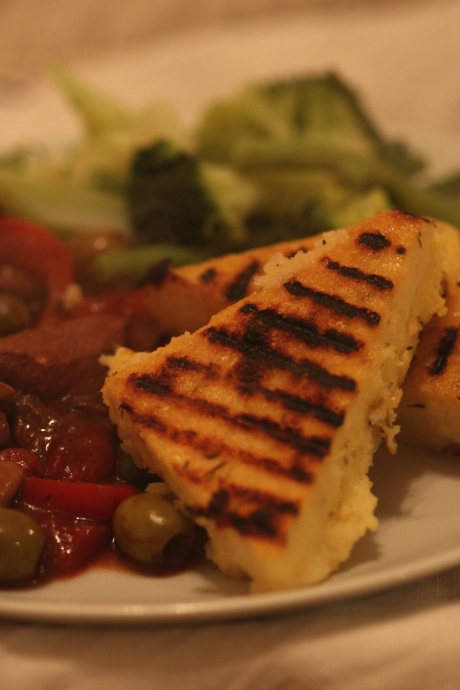I first came across polenta in Florence where I spent the third year of my degree in 1993. I was taken, by some Italian friends, to a rather dingy restaurant somewhere behind Santa Croce. It was away from the tourist traps on the main drag and I was told that this was where the locals ate. The menu came but I wasn’t given a choice. Polenta was ordered for me. I was told that it was a speciality of the restaurant. It arrived in a bowl, looking as unprepossessing as the locale. I stuck a spoon in and took a bite, expecting to be blown away as I was with all Italian food. Sadly (for me), I wasn’t impressed, finding it rather bland and a bit too ‘corny’. I added Parmesan and managed to eat the bowlful. I haven’t eaten it since then because how it was prepared wasn’t really to my palate.
Until tonight, that is. I wanted to make a Mediterranean-style pork casserole with red wine, tomatoes, red peppers, mushrooms and olives and I know that polenta is a classic accompaniment to such slow-cooked recipes. I thought that lemon and thyme would complement the flavours in this really well. So I chucked in some lemon juice and zest, some dried thyme, some Parmesan and garlic for good measure. I’m converted.
A word of warning if you’ve never cooked polenta before: If you’re adding extra ingredients to it, you really need to have all your ducks lined up before you start because the polenta needs vigorously whisking until it all of a sudden thickens and starts spitting. You really haven’t got time to be opening jars and measuring stuff out. Finally, finishing it off in the oven is not a traditional way to cook polenta but who’s got time to stand in front of the stove, stirring the pot for 45 minutes…?
Naturally gluten-free griddled polenta with Parmesan, lemon and thyme
Serves 6
olive oil
1.25l cold water
300g polenta/fine cornmeal
1½ tsp salt
50g Parmesan or Grana Padano, grated
zest and juice 1 lemon
2 tsp garlic granules
2 tsp dried thyme
You will also need a slab tin, 24cm x 20cm x 4cm
Preheat the oven to 190°C (fan-assisted). Grease and line the tin with baking parchment. Put the cold water in a very large saucepan and slowly add the polenta. You will need to whisk furiously in order to break up any lumps. Add the salt and bring slowly to the boil over a low to medium flame, whisking all the while (if you stop, the polenta sinks like silt to the bottom of the pan). Nothing will seem to happen for a while then, all of a sudden, it will thicken up and start spitting like a hot mud spring and you have to work quite fast. Add the cheese, lemon juice and zest, garlic granules and thyme and continue to whisk for a couple of minutes.
Take the polenta off the heat and pour into the prepared tin. Cover with aluminium foil and place in the oven. Bake for 45 minutes. Remove from the oven and take off the foil. Allow to cool slightly in the tin for about 20 minutes, then remove from the tin, peel off the parchment and allow to cool on a wire rack. When cool, cut into six rectangles (in half vertically and into three horizontally). Cut each rectangle in half on the diagonal.
Heat a cast-iron griddle pan or ordinary frying pan (skillet) over a high heat and brush each portion of polenta with olive oil. Griddle each side for about 3 minutes or until golden-brown. I served these with a Mediterranean-style pork and olive casserole (see pictures).

